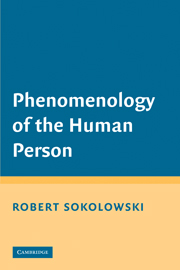Book contents
- Frontmatter
- Contents
- Acknowledgments
- Phenomenology of the Human Person
- Introduction
- PART I THE FORM OF THINKING
- PART II THE CONTENT OF THINKING
- PART III THE BODY AND HUMAN ACTION
- 12 The Body and the Brain
- 13 Active Perception and Declaratives
- 14 Mental Images and Lenses
- 15 Forms of Wishing
- 16 Declaring Our Wishes and Choices
- PART IV ANCIENTS AND MODERNS
- 19 Conclusion, with Henry James
- Bibliography
- Index
12 - The Body and the Brain
Published online by Cambridge University Press: 05 June 2012
- Frontmatter
- Contents
- Acknowledgments
- Phenomenology of the Human Person
- Introduction
- PART I THE FORM OF THINKING
- PART II THE CONTENT OF THINKING
- PART III THE BODY AND HUMAN ACTION
- 12 The Body and the Brain
- 13 Active Perception and Declaratives
- 14 Mental Images and Lenses
- 15 Forms of Wishing
- 16 Declaring Our Wishes and Choices
- PART IV ANCIENTS AND MODERNS
- 19 Conclusion, with Henry James
- Bibliography
- Index
Summary
If we are to explore what human conversation and thinking are, we must say something about the neurophysiology that underlies them. The brain, obviously, is involved in human experience and thought, and some people claim that thinking and consciousness can be completely explained as activities of the brain and nervous system. How shall we address this topic?
There are two ways of exploring the physiology associated with thinking. One is to pursue scientific research into the nervous system, to determine its structure and function, its chemical and electrical components and activities, and so on. Immense progress has been made in this project, and still greater advances are anticipated. The second way of exploring this issue is scientifically much more modest, but it has its own importance. It is to discuss how we speak about the brain and nervous system, and how our scientific speech about it can be integrated with our speech about ourselves as responsible speakers and agents. We can easily fall into confusion in this area; we might say, for example, that the brain feels pain, or that my brain recognizes my grandmother, or that the brain causes my thoughts. These statements are confused because it is not my brain but I myself who feel pain, recognize people, and think, just as it is I and not my brain that votes in an election or salutes an officer.
- Type
- Chapter
- Information
- Phenomenology of the Human Person , pp. 193 - 204Publisher: Cambridge University PressPrint publication year: 2008

